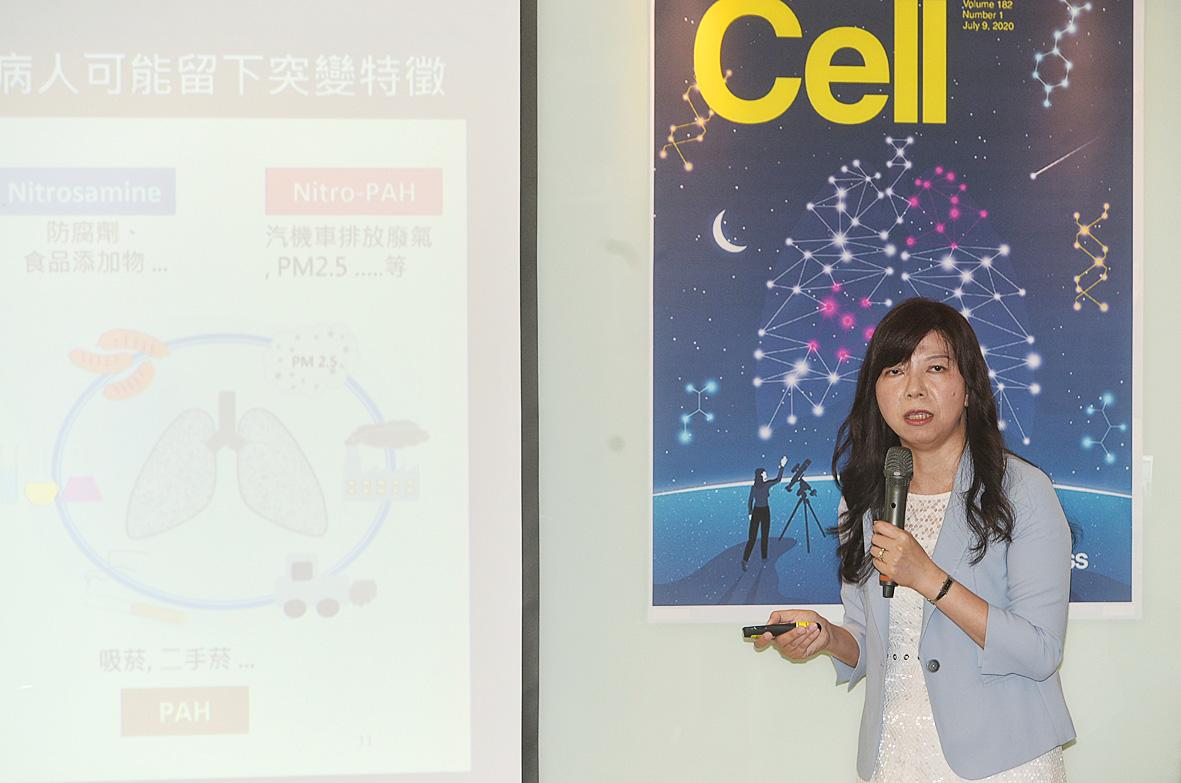A team of researchers yesterday unveiled the key genetic mutations of nonsmoking lung cancer patients, aiming to develop early diagnostic tools and precision medicine for the disease.
The study was a product of Taiwan’s participation in the US-led National Cancer Moonshot program since 2016, when Academia Sinica signed a memorandum of understanding with the US National Cancer Institute, Institute of Chemistry director Chen Yu-ju (陳玉如) told a news conference in Taipei.
While nearly 80 percent of lung adenocarcinoma patients in the US are chain smokers, more than half of the patients in Taiwan are nonsmokers, she said, adding that 93 percent of female patients do not smoke.

Photo: Chang Chia-ming, Taipei Times
It is a feature shared by many other East Asian countries, but the reason was unclear, she said, adding that the study was the first in East Asia to unravel the mystery.
Along with the US Clinical Proteomic Tumor Analysis Consortium, they studied tumor progression of patients in Taiwan and the US, she said.
Both studies were published in the journal Cell on Thursday last week and featured on its cover, showing an image of stargazers looking at a constellation that represents cancerous growth.
In Taiwan, up to 74 percent of female never-smokers (younger than 60 years old) showed higher mutation signatures of APOBEC — a family of proteins related to RNA editing, Chen said.
The team also identified a correlation between high APOBEC signatures and good responses to immunotherapy treatment, making APOBEC a potential biomarker for early diagnosis, she added.
Some environmental carcinogens might be drivers in early carcinogenesis, as indicated by the team’s findings about the metabolism and detoxification of carcinogens in females older than 70, Chen said.
Through the study, the team hopes to raise public awareness of the potential carcinogenesis of food additives, such as nitrosamine, which is used in fermented tofu and preserved radish, nitrated polycyclic aromatic hydrocarbons (nitro-PAHs) found in vehicle exhaust, cooking and secondhand smoke, as well as hereditary factors, Chen said.
As lung cancer symptoms mostly appear in late stages, most people have limited options other than immunotherapy and chemical therapy, which are costly, said National Taiwan University Hospital Division of Thoracic Surgery head Chen Jin-shing (陳晉興), who provided clinical samples for the study.
The study helps with the development of screening tools through blood testing, which would allow high-risk groups for lung cancer to avoid carcinogenic substances or behaviors, he said.
The study is the first phenomenal outcome of Taiwan’s Cancer Moonshot, with more expected to come, said former vice president Chen Chien-jen (陳建仁), now a distinguished research fellow at the institution’s Genomics Research Center.
However, the program has only received four years of funding, which is to end next year, Chen Yu-ru said.
The funding has shrunk annually, she added, while expressing the hope that the government would continue to support the program.

US climber Alex Honnold is to attempt to scale Taipei 101 without a rope and harness in a live Netflix special on Jan. 24, the streaming platform announced on Wednesday. Accounting for the time difference, the two-hour broadcast of Honnold’s climb, called Skyscraper Live, is to air on Jan. 23 in the US, Netflix said in a statement. Honnold, 40, was the first person ever to free solo climb the 900m El Capitan rock formation in Yosemite National Park — a feat that was recorded and later made into the 2018 documentary film Free Solo. Netflix previewed Skyscraper Live in October, after videos

NUMBERS IMBALANCE: More than 4 million Taiwanese have visited China this year, while only about half a million Chinese have visited here Beijing has yet to respond to Taiwan’s requests for negotiation over matters related to the recovery of cross-strait tourism, the Tourism Administration said yesterday. Taiwan’s tourism authority issued the statement after Chinese-language daily the China Times reported yesterday that the government’s policy of banning group tours to China does not stop Taiwanese from visiting the country. As of October, more than 4.2 million had traveled to China this year, exceeding last year. Beijing estimated the number of Taiwanese tourists in China could reach 4.5 million this year. By contrast, only 500,000 Chinese tourists are expected in Taiwan, the report said. The report

Temperatures are forecast to drop steadily as a continental cold air mass moves across Taiwan, with some areas also likely to see heavy rainfall, the Central Weather Administration (CWA) said. From today through early tomorrow, a cold air mass would keep temperatures low across central and northern Taiwan, and the eastern half of Taiwan proper, with isolated brief showers forecast along Keelung’s north coast, Taipei and New Taipei City’s mountainous areas and eastern Taiwan, it said. Lows of 11°C to 15°C are forecast in central and northern Taiwan, Yilan County, and the outlying Kinmen and Lienchiang (Matsu) counties, and 14°C to 17°C

STEERING FAILURE: The first boat of its class is experiencing teething issues as it readies for acceptance by the navy, according to a recent story about rudder failure The Hai Kun (海鯤), the nation’s first locally built submarine, allegedly suffered a total failure of stern hydraulic systems during the second round of sea acceptance trials on June 26, and sailors were forced to manually operate the X-rudder to turn the submarine and return to port, news Web site Mirror Daily reported yesterday. The report said that tugboats following the Hai Kun assisted the submarine in avoiding collisions with other ships due to the X-rudder malfunctioning. At the time of the report, the submarine had completed its trials and was scheduled to begin diving and surfacing tests in shallow areas. The X-rudder,